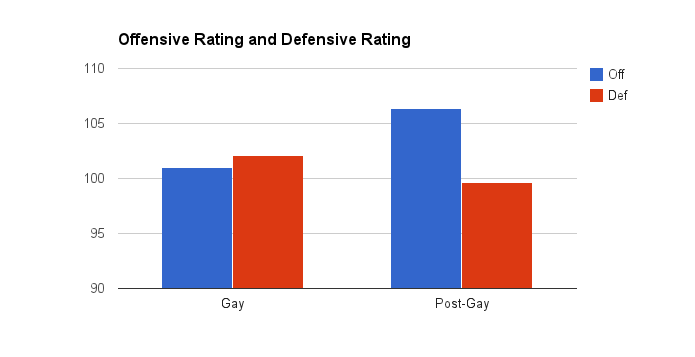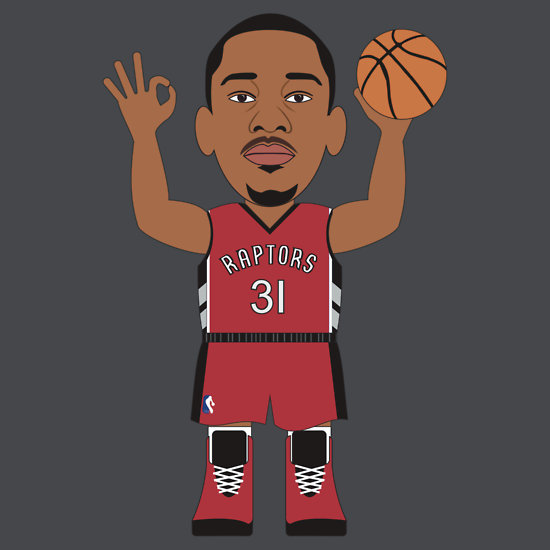Spoiler alert: the results are exactly what you’d expect.
Much has been made of the Rudy Gay trade. When the deal went down, many pundits (including most of us) proclaimed that it was a clear indication of Masai Ujiri’s intentions. By trading away the team’s perceived star player and number-one option for a collection of spare parts and salary fodder, the Raptors were boldly throwing their hats into the tanking ring, opting to join the ranks of Milwaukee, Utah, Philadelphia and many others in the race to accumulate ping-pong balls. Every present asset is now for sale at the price of future value. If you play for the Toronto Raptors and your name isn’t Jonas, keep your bags packed, especially if you’re on an expiring contract (Lowry) or if you’re a wily veteran (Novak, Hansbrough).
Then something happened, something fans and pundits alike didn’t expect – the Raptors started winning. Since the Rudy Gay trade, the Raptors have won 3 out of 4 games, 2 of which have come on the road (@LAL, PHI, @CHI) and dropping a no-contest at home to the 19-4 San Antonio Spurs.
It appears that the Raptors might have actually…improved?
By all accounts the Raptors have performed much better. Yes, their victories have come against some sub-par opponents (all sub .500), but the team’s improvements certainly pass the eye test (the eye test being whether watching the Raptors offense causes your eyes to bleed or not). The ball isn’t sticking nearly as much, there is more motion in the offense, the front-court is getting more touches and there isn’t a whole swath of isolation plays drawn up for our wing players.
First and foremost, the Raptors have performed better on both offense AND defense. In the 18 games with Gay in the lineup, the Raptors’ net rating (Offensive rating minus Defensive Rating) ranked 18th in the NBA at -1.1 (101.0/102.1). In 4 games without Gay, the Raptors are 8th in net rating at +6.8 (106.4/99.6).
 The improvements in the offense have been accompanied by upticks in assist numbers, suggesting an increase in ball-movement (which totally passes the eye test). The Raptors are averaging more total assists per game, improving from 30th to 11th in the NBA (23.0 vs 17.3), and the Raptors have also registered a higher assist ratio (% of possessions ending in an assist, 17.81 vs 13.71). In particular, Derozan and Lowry have both posted higher assist numbers in Gay’s absence and the addition of Greivis Vasquez has also undoubtedly helped facilitate ball-movement.
The improvements in the offense have been accompanied by upticks in assist numbers, suggesting an increase in ball-movement (which totally passes the eye test). The Raptors are averaging more total assists per game, improving from 30th to 11th in the NBA (23.0 vs 17.3), and the Raptors have also registered a higher assist ratio (% of possessions ending in an assist, 17.81 vs 13.71). In particular, Derozan and Lowry have both posted higher assist numbers in Gay’s absence and the addition of Greivis Vasquez has also undoubtedly helped facilitate ball-movement.
 The composition of the Raptors offense also looks completely different, shifting from an isolation oriented offense to a more motion-heavy, pick-and-roll based offense. According to data from Synergy Sports, the Raptors are spending less possessions on isolation plays, and more on pick-and-roll (split into ball-handler and roll-man). Seasonal averages and post-Gay numbers are shown below (calculations shown here). The main beneficiaries of this new offense are Valanciunas and Johnson, who have both seen upticks in their usage rates (reflected in increase in PnR). The shift away from isolation plays has also allowed the Raptors to play at a significantly faster pace (97.40 vs 94.82):
The composition of the Raptors offense also looks completely different, shifting from an isolation oriented offense to a more motion-heavy, pick-and-roll based offense. According to data from Synergy Sports, the Raptors are spending less possessions on isolation plays, and more on pick-and-roll (split into ball-handler and roll-man). Seasonal averages and post-Gay numbers are shown below (calculations shown here). The main beneficiaries of this new offense are Valanciunas and Johnson, who have both seen upticks in their usage rates (reflected in increase in PnR). The shift away from isolation plays has also allowed the Raptors to play at a significantly faster pace (97.40 vs 94.82):
 Perhaps as a result of running more pick and rolls, the Raptors are also shooting a significantly higher percentage in the restricted area. While Gay was on the team, the Raptors shot a putrid 55.4% in the restricted area in large part due to Gay’s uncharacteristic inability to finish at the rim this season (52% this season vs career ~60% shooter at the rim). With Gay out and more shots for Valanciunas and Johnson, the Raptors are shooting a whopping 73% in the restricted area.
Perhaps as a result of running more pick and rolls, the Raptors are also shooting a significantly higher percentage in the restricted area. While Gay was on the team, the Raptors shot a putrid 55.4% in the restricted area in large part due to Gay’s uncharacteristic inability to finish at the rim this season (52% this season vs career ~60% shooter at the rim). With Gay out and more shots for Valanciunas and Johnson, the Raptors are shooting a whopping 73% in the restricted area.
Lastly, Gay’s departure has freed up a giant swath of possessions (Gay’s usage rate in Toronto was ~30%) for his former teammates and many have increased their production in his wake.
Terrence Ross has taken Gay’s spot in the starting lineup and he has looked impressive. In four games, Ross has upped his scoring (14.5 ppg from 6.2), rebounding (4.5 per game vs 2.5) and shooting percentage (55.1 TS% vs 51.4 TS%) all while taking on an expanded role in the offense (20.2 usage rate vs 14.7).
Amir Johnson has also seen a significant uptick in his numbers. As usual, Amir has been fantastic in pick and roll/pop situations, but he’s also scoring more on post-ups. Johnson has scored 20.5 points per game on 76 TS% in Gay’s absence as compared to 9.6 ppg on 59 TS%, all while increasing his usage rate (18.9 vs 14.6).
Finally, although many believed that Gay’s departure would have a negative impact on Derozan’s production, Demar’s numbers pre and post-trade have looked more or less the same. He’s using about the same amount of possessions (~26%) while scoring at the exact same rate (53.9 TS%). However now that Demar is taking on more ball-handling responsibilities in the starting lineup, he’s managed to create more shots for his teammates, as evidenced by the increase in his assist ratio (19.9% vs 11.0%).
So all in all, the trade seems to have actually improved the team in the early going. The metrics and the eye test both agree – the offense has performed much better thanks to increased ball movement in Gay’s absence. The Raptors are (thankfully) running fewer isolation plays and more pick and rols for both the ball-handler and the roll-man. As a result, the Raptors are shooting a better percentage from the field while assisting on more of their baskets. The main beneficiaries of the trade have been Johnson and Ross, who have filled much of the void left by Gay and improved both their output and their efficiencies. Meanwhile Demar Derozan, despite becoming the “number-one option”, and consequently the focal point of opposing defenses, has largely managed to keep his production constant.
But before you plan the parade route and apply the finishing touches on the Ujiri float, don’t forget to dip your toes into the cold waters of reality. While the metrics certainly paint a rosier picture, we are dealing with a miniscule sample size of four games. Just as a reference, 4 games is ~1/3 of 13, which is the number of games in which Bargnani averaged 24 and 6 on 47% shooting in 2011. Or, if you’d prefer, 4 is twice as large as 2, which is the number of games that Gay has played in a Kings uniform and averaged 25 points per game on 56% percent shooting from the field. These numbers are descriptive, meaning that they’re an account of what’s happened, but they aren’t predictive, meaning they don’t necessarily indicate how things “will be” going forward.
Regardless, it’s a fresh breath of air for us fans. We’re getting a glimpse of what could be; a fluid, motion based offense revolved around 1/4 pick-and-rolls and drives from the wings, rather than the stagnant, isolation-heavy attack that left our wits senseless, our throats hoarse, and our eyes poked out. And really, we can’t lose either way. If the Raptors are legitimately improved, we get to enjoy a young team on the upswing with potential and flexibility. If not, we regress and we finish with a high lottery pick, affording Masai the ability to add a blue-chip prospect via the draft.
Statistical support courtesy of Synergy Sports, Basketball-Reference, Hoopdata and NBA Stats. H/T to TheScore on the cover photo.



